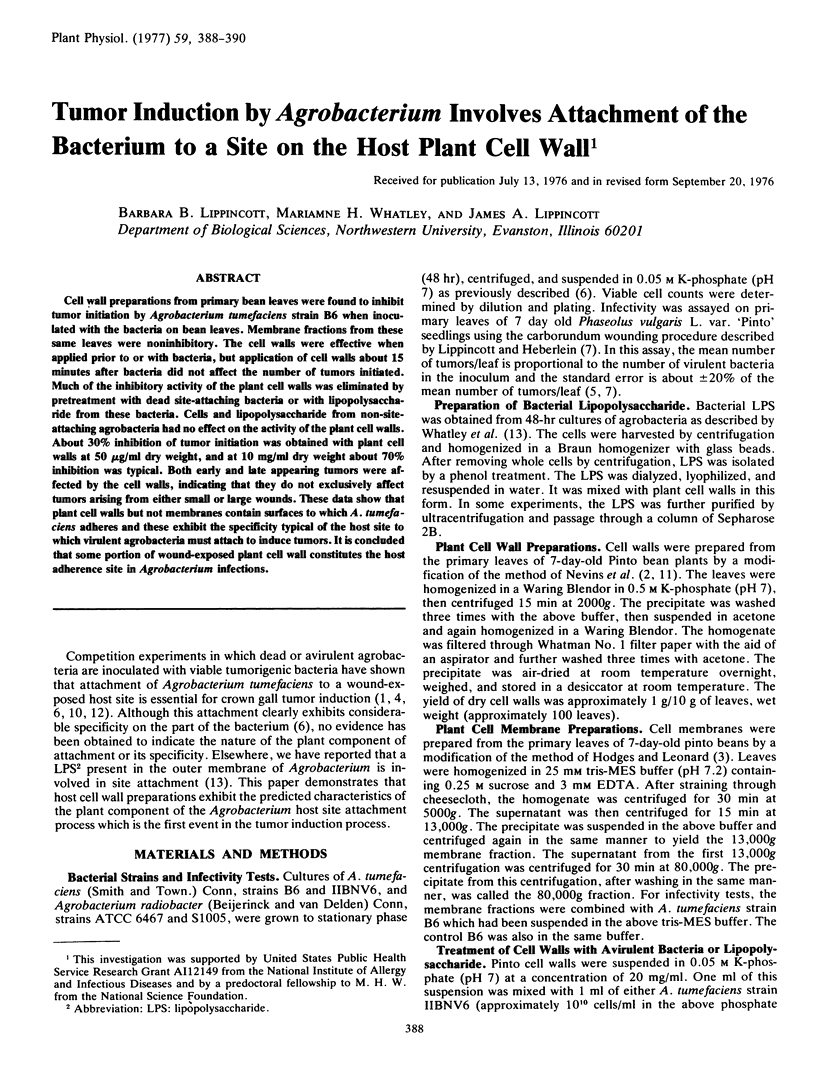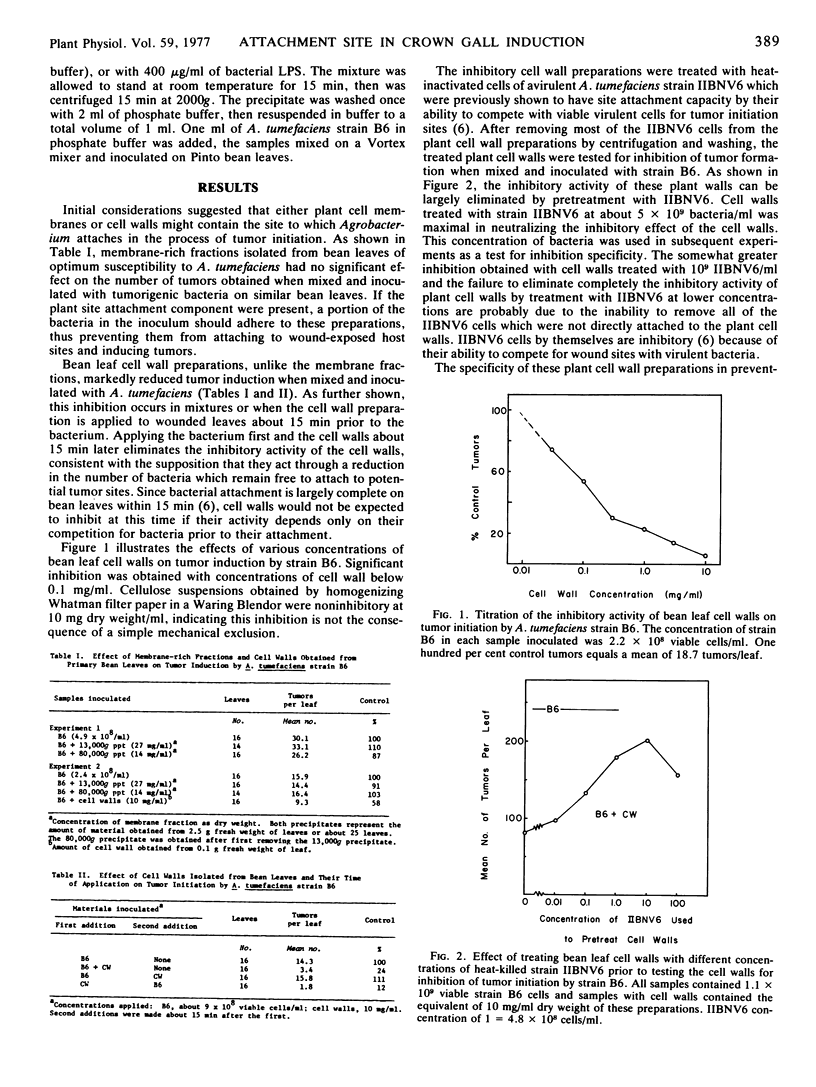Abstract
Cell wall preparations from primary bean leaves were found to inhibit tumor initiation by Agrobacterium tumefaciens strain B6 when inoculated with the bacteria on bean leaves. Membrane fractions from these same leaves were noninhibitory. The cell walls were effective when applied prior to or with bacteria, but application of cell walls about 15 minutes after bacteria did not affect the number of tumors initiated. Much of the inhibitory activity of the plant cell walls was eliminated by pretreatment with dead site-attaching bacteria or with lipopolysaccharide from these bacteria. Cells and lipopolysaccharide from non-site-attaching agrobacteria had no effect on the activity of the plant cell walls. About 30% inhibition of tumor initiation was obtained with plant cell walls at 50 μg/ml dry weight, and at 10 mg/ml dry weight about 70% inhibition was typical. Both early and late appearing tumors were affected by the cell walls, indicating that they do not exclusively affect tumors arising from either small or large wounds. These data show that plant cell walls but not membranes contain surfaces to which A. tumefaciens adheres and these exhibit the specificity typical of the host site to which virulent agrobacteria must attach to induce tumors. It is concluded that some portion of wound-exposed plant cell wall constitutes the host adherence site in Agrobacterium infections.
Full text
PDF


Selected References
These references are in PubMed. This may not be the complete list of references from this article.
- English P. D., Maglothin A., Keegstra K., Albersheim P. A Cell Wall-degrading Endopolygalacturonase Secreted by Colletotrichum lindemuthianum. Plant Physiol. 1972 Mar;49(3):293–298. doi: 10.1104/pp.49.3.293. [DOI] [PMC free article] [PubMed] [Google Scholar]
- Hodges T. K., Leonard R. T. Purification of a plasma membrane-bound adenosine triphosphatase from plant roots. Methods Enzymol. 1974;32:392–406. doi: 10.1016/0076-6879(74)32039-3. [DOI] [PubMed] [Google Scholar]
- Lippincott B. B., Lippincott J. A. Bacterial attachment to a specific wound site as an essential stage in tumor initiation by Agrobacterium tumefaciens. J Bacteriol. 1969 Feb;97(2):620–628. doi: 10.1128/jb.97.2.620-628.1969. [DOI] [PMC free article] [PubMed] [Google Scholar]
- Lippincott B. B., Lippincott J. A. Characteristics of Agrobacterium tumefaciens auxotrophic mutant infectivity. J Bacteriol. 1966 Oct;92(4):937–945. doi: 10.1128/jb.92.4.937-945.1966. [DOI] [PMC free article] [PubMed] [Google Scholar]
- Lippincott J. A., Heberlein G. T. The quantitative determination of the infectivity of Agrobacterium tumefaciens. Am J Bot. 1965 Sep;52(8):856–863. [PubMed] [Google Scholar]
- Lippincott J. A., Lippincott B. B. The genus Agrobacterium and plant tumorigenesis. Annu Rev Microbiol. 1975;29:377–405. doi: 10.1146/annurev.mi.29.100175.002113. [DOI] [PubMed] [Google Scholar]
- Lippincott J. A., Lippincott B. B. Timing of events in crown-gall tumor development on Pinto bean leaves. Dev Biol. 1965 Oct;12(2):309–327. doi: 10.1016/0012-1606(65)90033-3. [DOI] [PubMed] [Google Scholar]
- Manigault P. Intervention dans la plaie d'inoculation de bactéries appartenant à différentes souches d'Agrobacterium tumefacients (Smith et Town) Conn. Ann Inst Pasteur (Paris) 1970 Sep;119(3):347–359. [PubMed] [Google Scholar]
- Nevins D. J., English P. D., Albersheim P. The specific nature of plant cell wall polysaccharides. Plant Physiol. 1967 Jul;42(7):900–906. doi: 10.1104/pp.42.7.900. [DOI] [PMC free article] [PubMed] [Google Scholar]
- Whatley M. H., Bodwin J. S., Lippincott B. B., Lippincott J. A. Role of Agrobacterium cell envelope lipopolysaccharide in infection site attachment. Infect Immun. 1976 Apr;13(4):1080–1083. doi: 10.1128/iai.13.4.1080-1083.1976. [DOI] [PMC free article] [PubMed] [Google Scholar]


